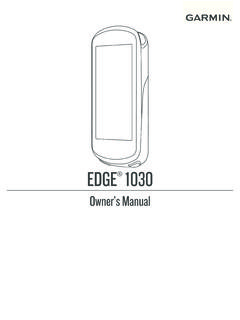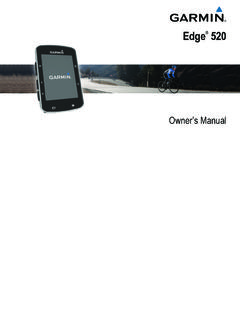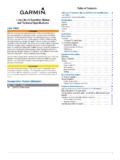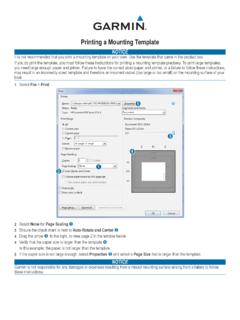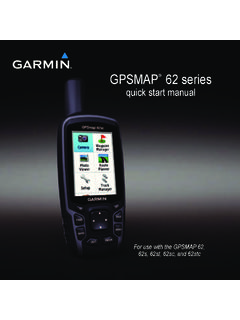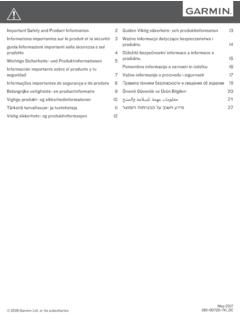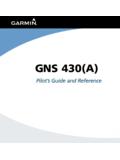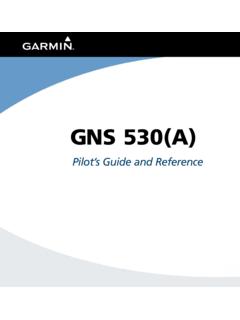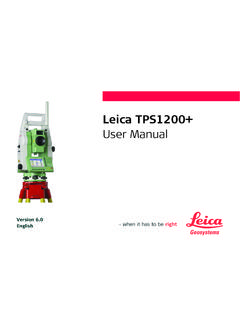Transcription of Instructions - Garmin
1 GLO GLONASS and GPS sensor Instructions August 2012 190-01492-00_0B Printed in Taiwan1. Installing the Battery The release tab locks the cover in place. Warning This product contains a lithium-ion battery. Replacement Battery See page 5 for important battery safety You can purchase a replacement battery information. (010-10840-00) at 1 With your thumbnail, slide the battery Charging the Battery cover release tab . You can use the sensor while you are charging it. 1 Plug the small end of the power cable into the mini-USB connector on the end of the sensor . 2 Plug the other end of the power cable into an appropriate source of power for the cable type. 2 Remove the battery cover . It takes about three hours to charge the 3 Locate the metal contacts on the end battery. A fully charged battery lasts about of the lithium-ion battery. 12 hours. 4 Insert the battery so the metal Note: If the battery has not been charged contacts on the battery align with for a long period of time, remove the the metal contacts inside the battery battery, connect the cable to the device compartment.
2 And a power source, and then replace the 5 Press the battery down into place. battery. The battery will charge as usual. 6 Insert the battery cover into the notches and press down. 2 . Pairing the sensor Status LED. 1 Hold to turn on the sensor . LED Description 2 Turn on the other device and enable Slow flashing orange Charging the Bluetooth component. Solid orange Battery charged, You can refer to the device's power connected. documentation for specific Instructions Orange off Battery charged, about enabling Bluetooth wireless power disconnected. technology. Rapid flashing orange Low battery 3 Bring the sensor within 30 feet (10 Alternating orange Faulty battery or meters) of the mobile device. and green system error Flashing green Searching for GPS. 4 Using the mobile device, pair the satellites sensor with the mobile device. Solid green GPS satellite fix The blue LED is solid blue when the sensor is connected to the other device.
3 Acquiring Satellite Signals If the sensor has not established a Bluetooth connection for several minutes, 1 Verify that the blue LED on the sensor is solid blue, indicating a wireless it turns off automatically. connection. Bluetooth LED 2 Place the sensor where it has a clear LED Description view of the sky. Slow flashing Searching for mobile devices Acquiring satellite signals may take a blue few minutes. The Status LED flashes Rapid flashing Pairing green while searching for satellites and blue establishing your location. The Status LED. Solid blue Connected to mobile device is solid green when it has established a fix on your location. 3. Using the Portable Friction not responsible for the operation of this device or its compliance with safety and Mount regulatory standards. Please note that the The portable friction mount comes in use of this accessory with iPod, iPhone, or some GLO packages and is available as iPad may affect wireless performance.
4 An optional accessory. The GLO sensor is also compatible with 1 Wipe the mounting surface and the many Android , Windows or Blackberry . back of the mount with a wet cloth to smartphones, tablets and notebook remove dust and debris. computers. 2 Insert the sensor in the mount so the When using the GLO GPS/GLONASS. LEDs face up and the mini-USB port is sensor with an Android device, you accessible. may need to use an application to allow 3 Place on a flat surface. the sensor to properly communicate Periodically, you should wipe the surface with the Android system over Bluetooth and the mount with a wet cloth to remove technology. The application will allow the dust and debris to help prevent the mount Android system to accept non-system (or from sliding. mock) GPS/GLONASS signals. Product Compatibility Registering the Device Made for iPod touch (4th generation), Go to iPod touch (3rd generation), iPhone 4S, Keep the original sales receipt, or a iPhone 4, iPhone 3GS, iPad 2, and iPad.
5 Photocopy, in a safe place. "Made for iPod, iPhone, iPad means that an electronic accessory has been Specifications designed to connect specifically to iPod, Case: Rugged, but not water-resistant iPhone, or iPad, respectively, and has Power Supply: Rechargeable lithium-ion been certified by the developer to meet battery, 12 hours (typical use). Apple performance standards. Apple is 4 . Update Rate: 10 Hz, but not all mobile . Do not place the device in front of or devices support a 10 Hz update rate. above any airbag . Vehicle Power Cable* Input Voltage: 12 28 Vdc (*available in some packages).. Operating Temperature: -4 F to 140 F. (-20 C to 60 C) . Charging Temperature: 32 F to 113 F. (0 C to 45 C) Battery Warnings Short-Term (1 month) Storage If these guidelines are not followed, the Temperature: -4 F to 122 F (-20 C to battery may experience a shortened life 50 C) span or may present a risk of damage to the sensor , fire, chemical burn, electrolyte Long-Term (1 year) Storage leak, and/or injury.
6 Temperature: -4 F to 68 F (-20 C to 20 C) Do not leave the sensor exposed to a heat source or in a high temperature location, such as in the sun in an Important Safety and Product unattended vehicle. To prevent the Information possibility of damage, remove the device from the vehicle or store it out Warning of direct sunlight, such as in the glove Installation Warnings box. When installing the device in a vehicle, Do not use a sharp object to remove place the device securely so it does not the battery. obstruct the driver's view of the road or Do not disassemble, puncture, interfere with vehicle operating controls, incinerate, or damage the battery. such as the steering wheel, foot pedals, Keep the battery away from children. or transmission levers. Do not place unsecured on the vehicle dashboard 5. If using an external battery charger, used to determine ground proximity for only use the Garmin accessory aircraft navigation.
7 Approved for your product. Only replace the battery with the Product Environmental Programs correct replacement battery. Using Information about Garmin 's product another battery presents a risk of recycling program and WEEE, RoHS, fire or explosion. To purchase a REACH, and other compliance programs replacement battery, see your Garmin can be found at dealer or the Garmin website. /aboutGarmin/environment. When storing the device for an Declaration of Conformity extended time, store within the Hereby, Garmin , declares that this following temperature range: from -4 F. product is in compliance with the to 68 F (-20 C to 20 C). essential requirements and other relevant Do not operate the device outside of provisions of Directive 1999/5/EC. To view the following temperature range: from the full Declaration of Conformity, go to -4 F to 140 F (-20 C to 60 C). Contact your local waste disposal department to dispose of the device/ FCC Compliance battery in accordance with applicable This device complies with part 15 of the local laws and regulations.
8 FCC Rules. Operation is subject to the following two conditions: (1) this device Navigation Warnings may not cause harmful interference, Use this sensor only as a navigational aid. and (2) this device must accept any Do not attempt to use the sensor for any interference received, including purpose requiring precise measurement interference that may cause undesired of direction, distance, location, or operation. topography. This product should not be This equipment has been tested and found to comply with the limits for a 6 . Class B digital device, pursuant to This product does not contain any user- part 15 of the FCC rules. These limits serviceable parts. Repairs should only be are designed to provide reasonable made by an authorized service center. protection against harmful interference in Unauthorized repairs or modifications a residential installation. This equipment could result in permanent damage to the generates, uses, and can radiate radio equipment, and void your warranty and frequency energy and may cause harmful your authority to operate this device under interference to radio communications if Part 15 regulations.
9 Not installed and used in accordance with the Instructions . However, there is no Industry Canada Compliance guarantee that interference will not occur Category I radiocommunication devices in a particular installation. If this equipment comply with Industry Canada Standard does cause harmful interference to radio RSS-210. Category II radiocommunication or television reception, which can be devices comply with Industry Canada determined by turning the equipment off Standard RSS-310. This device complies and on, the user is encouraged to try to with Industry Canada license-exempt RSS. correct the interference by one of the standard(s). Operation is subject to the following measures: following two conditions: (1) this device Reorient or relocate the receiving may not cause interference, and (2) this antenna. device must accept any interference, including interference that may cause Increase the separation between the undesired operation of the device.
10 Equipment and the receiver. Connect the equipment into an outlet Limited Warranty that is on a different circuit from the Garmin 's standard limited warranty applies GPS unit. to this accessory. For more information, Consult the dealer or an experienced go to radio/TV technician for help..html. 7. 913-397-8200 0808 238 0000. 1-866-429-9296 43 (0) 3133 3181 0. 1-800-800-1020 +44 870 850 1242. 00 32 2 672 52 54 00 45 4810 5050 00 358 9 6937 9758 00 331 55 69 33 99. 0180 5 / 42 76 46 - 880 00 39 02 3669 9699 0800-0233937 815 69 555. 00800 4412 454. 00 35 1214 447 460 00 34 902 007 097 00 46 7744 52020. +44 2380 662 915. Garmin and the Garmin logo are trademarks of Garmin Ltd. or its subsidiaries, registered in the USA and other countries. Garmin International, Inc GLO is a trademark of Garmin Ltd. or its subsidiaries. These 1200 East 151st Street, trademarks may not be used without the express permission of Olathe, Kansas 66062, USA Garmin .

